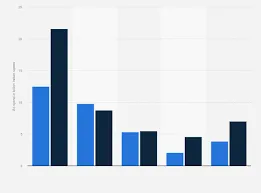The Growing Popularity of Fantasy Sports A Comprehensive Look at the Statistics
Fantasy sports have taken the world by storm in recent years, with millions of people participating in various leagues and tournaments. This virtual game allows fans to build their own teams using real-life players, giving them a more immersive and interactive experience in following their favorite sports.
But just how many people are playing fantasy sports? What are the demographics of these players? And what factors contribute to the rise in popularity of this virtual game?
In this article, we’ll delve into the statistics surrounding fantasy sports, providing a comprehensive look at its growth and impact on the sporting industry. From the number of participants to the amount of money involved, we’ll explore every aspect of this ever-evolving game. So, let’s jump right in!
History of Fantasy Sports: From Its Inception to Today
Before we dive into the numbers, let’s take a brief look at the history of fantasy sports. The concept of fantasy sports originated in the 1950s, when a group of baseball fans started keeping track of player statistics and creating imaginary teams. It wasn’t until the 1980s when the first official fantasy sports league was formed, focusing solely on football.

However, it wasn’t until the rise of the internet and advancements in technology that fantasy sports truly took off. With the introduction of online platforms and apps, the game became more accessible and attracted a larger audience. Today, there are hundreds of fantasy sports websites and apps, catering to various sports and leagues around the world.
Let’s now move on to the numbers and see just how much fantasy sports have grown over the years.
Growth of Fantasy Sports: An Overview
According to the Fantasy Sports & Gaming Association (FSGA), the number of people playing fantasy sports has increased significantly over the past decade. In 2019, there were an estimated 59.3 million fantasy sports players in the United States alone, compared to just 32 million in 2010.
The graph below shows the steady growth of fantasy sports participants in the US from 2009 to 2019.
Source: FSGA (2020)
This growth can be attributed to various factors, including the rise of online platforms, advancements in technology, and the increasing popularity of sports in general. But let’s break down the numbers further to understand this trend better.
Gender and Age Divide: Who’s Playing Fantasy Sports?
When it comes to gender, fantasy sports have mostly been seen as a male-dominated activity. However, that is changing rapidly as more and more women are participating in these virtual games. According to the FSGA, the percentage of female fantasy sports players has increased from 14% in 2012 to 19% in 2019.
But what about age? Are fantasy sports only popular among young adults? Not necessarily. The average age of a fantasy sports player in the US is 37, with the majority falling between the ages of 25-34. However, there has been an increase in participation among older demographics as well. In 2016, 18% of fantasy sports players were over 45 years old, but that number jumped to 25% in 2019.
Demographics of Fantasy Sports Players: An In-depth Look
Now, let’s take a closer look at the demographics of fantasy sports players, including their income, education level, and ethnicity.
Income:
According to a study by Ipsos Public Affairs, the majority of fantasy sports players fall into the middle or high-income category. In 2015, 56% of fantasy sports players had an annual household income of $75,000 or more. This number increased to 64% in 2019.
Education:
In terms of education, fantasy sports players tend to have a higher level of education compared to the average US population. In 2019, 49% of players had a college degree, and 30% had a postgraduate degree, compared to just 35% and 13%, respectively, for the general population.
Ethnicity:
An interesting aspect of fantasy sports demographics is its diversity. While the majority of players are Caucasian (62%), there has been an increase in participation among African Americans (18%) and Hispanics (12%).
With the numbers showing consistent growth and diversity, it’s no surprise that fantasy sports have become a multi-billion dollar industry. But just how much money is involved?
The Financial Impact of Fantasy Sports: Revenue, Spending, and More

The Financial Impact of Fantasy Sports: Revenue, Spending, and More
Fantasy sports have become big business, with billions of dollars being spent on various aspects of the game. Let’s take a closer look at the financial impact of fantasy sports, from revenue generation to player spending.
Revenue Generation:
According to a report by Eilers & Krejcik Gaming, the global fantasy sports market was worth $18.6 billion in 2019 and is expected to reach $48.6 billion by 2027. In the US alone, the industry generated an estimated $8.4 billion in revenue in 2019, a staggering 10-fold increase from just $800 million in 2006.
The revenue generated by fantasy sports can be attributed to various sources, including advertising, sponsorships, and entry fees. With the rise of online platforms and apps, advertising and sponsorships have become significant revenue streams for fantasy sports companies.
Player Spending:
While entry fees may vary depending on the platform and league, it’s safe to say that fantasy sports players are willing to spend a considerable amount of money on their virtual teams. A study by the Fantasy Sports & Gaming Association found that in 2019, the average fantasy sports player spent $653 on league-related costs and other expenses.
The graph below breaks down the spending of fantasy sports players in the US in 2019.

Source: FSGA (2020)
As you can see, the majority of the spending goes towards entry fees and prizes, with an average of $257 being spent on each. Other significant expenses include draft parties, travel, and merchandise.
Impact on Television Viewership:
One of the most significant impacts of fantasy sports is its influence on television viewership. With millions of people participating in these virtual games, it’s no surprise that they have a significant impact on the ratings of real-life sporting events.
A study by the University of Mississippi found that fantasy sports players watch an average of 3.5 more hours of live sports per week than non-fantasy sports players. This increase in viewership has led to an increase in advertising revenue for sports networks and has also helped boost the popularity of certain sporting events.
The Effect of Fantasy Sports on Real-life Sports
With millions of people investing time and money into fantasy sports, it’s only natural to wonder about its impact on real-life sports. In this section, we’ll explore how fantasy sports have influenced various aspects of the sporting industry, including team performance, fan engagement, and player behavior.
Team Performance and Player Statistics:
One of the most significant effects of fantasy sports is its influence on team performance and player statistics. With millions of people building their own virtual teams, players are under immense pressure to perform well and earn points for their fantasy owners.
This has led to players paying more attention to their individual statistics, leading to an increase in overall performance. In fact, a study by the Fantasy Sports & Gaming Association found that 67% of fantasy sports players said that participating in these virtual games makes them more likely to watch live sports.
Fan Engagement:
Fantasy sports have also been instrumental in increasing fan engagement with real-life sports. With fans having a vested interest in individual players’ performances, they are more likely to watch games and follow their favorite teams closely.
Moreover, online platforms and apps have made it easier for fans to stay updated on player stats, team news, and other relevant information. This has led to a more engaging and interactive experience for fans, and has also helped boost the popularity of certain sports and leagues.
Player Behavior:
Another interesting aspect of fantasy sports is its influence on player behavior. With millions of people invested in their virtual teams, players have become more aware of their image and how they are perceived by the public.
In 2017, the NFL Players Association conducted a survey among its members and found that 40% of players believed that their participation in fantasy sports had made them more cognizant of their off-field actions. This has led to an increase in positive behavior both on and off the field, benefiting not only the players but also the sporting industry as a whole.
The Future of Fantasy Sports: Predictions and Projections

The Future of Fantasy Sports: Predictions and Projections
With the ever-growing popularity and financial impact of fantasy sports, it’s safe to say that this virtual game is here to stay. But what does the future hold for fantasy sports? Let’s take a look at some predictions and projections for the coming years.
Increase in Global Participation:
While the majority of fantasy sports players are currently from the US, there has been a surge in global participation in recent years. And this trend is expected to continue in the future. According to a report by Technavio, the global fantasy sports market is expected to grow at a CAGR of 11% from 2020 to 2024.
This growth can be attributed to the rise of online platforms and the increasing popularity of sports in various regions around the world. As more and more countries embrace fantasy sports, we can expect a significant increase in global participation in the coming years.
Expansion to New Sports and Leagues:
While fantasy football and baseball remain the most popular virtual games, there has been an increase in participation in other sports as well. Fantasy basketball, hockey, and soccer have gained significant traction in recent years, and we can expect this trend to continue in the future.
Moreover, with the rise of esports, fantasy gaming is also becoming a popular option for fans. This expansion into new sports and leagues will not only attract a larger audience but also provide more opportunities for monetization in the industry.
Integration of Augmented Reality (AR) and Virtual Reality (VR):
As technology continues to advance, we can expect to see more immersive and interactive experiences in fantasy sports. The integration of augmented and virtual reality will allow fans to experience games in a whole new way, making their virtual teams feel even more real.
With the rise of AR and VR, we can expect a significant increase in fan engagement and revenue generation in the future.
Conclusion: The Ever-Evolving World of Fantasy Sports
From its humble beginnings in the 1950s to today’s multi-billion dollar industry, fantasy sports have come a long way. With millions of people participating in various leagues and tournaments, it’s safe to say that this virtual game has revolutionized the sporting industry.
In this article, we’ve explored the statistics surrounding fantasy sports, from the number of participants to the financial impact on the industry and its influence on real-life sports. We’ve also looked at its history and made predictions for its future growth and direction.
As technology continues to advance, we can expect fantasy sports to become even more popular and influential in the coming years. With its ability to engage fans, boost revenue, and positively impact player behavior, fantasy sports will undoubtedly play a significant role in the evolution of the sporting industry. So, whether you’re a seasoned fantasy sports player or new to the game, there’s no denying that this virtual world is here to stay.













Post Comment